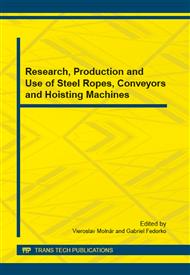[1]
F. Parvizian, A. Güzel, A. Jäger, B. Lambers, B. Svendsen, A.E. Tekkaya, H.J. Maier, Modeling of dynamic microstructure evolution of EN AW-6082 alloy during hot forward extrusion, Computational materials science 50 (2011) 1520–1525.
DOI: 10.1016/j.commatsci.2010.12.009
Google Scholar
[2]
S. Das, L. Pelcastre, J. Hardell, B. Prakash, Effect of static and dynamic ageing on wear and friction behavior of aluminum 6082 alloy, Tribology international 60 (2013) 1–9.
DOI: 10.1016/j.triboint.2012.10.019
Google Scholar
[3]
I. Duarte, M. Vesenjak, L. Krstulovic-Opara, Dynamic and quasi-static bending behavior of thin-walled aluminum tubes filled with aluminum foam, Composite structures 109 (2014) 48–56.
DOI: 10.1016/j.compstruct.2013.10.040
Google Scholar
[4]
L. Guo, J. Yu, Dynamic bending response of double cylindrical tubes filled with aluminum foam, International journal of impact engineering 38 (2011) 85–94.
DOI: 10.1016/j.ijimpeng.2010.10.004
Google Scholar
[5]
K. Kabir, T. Vodenitcharova, M. Hoffman, Response of aluminum foam-cored sandwich panels to bending load, Composites: Part B 64 (2014) 24–32.
DOI: 10.1016/j.compositesb.2014.04.003
Google Scholar
[6]
Y. Conde, A. Pollien, A. Mortensen, Functional grading of metal foam cores for yield-limited lightweight sandwich beams, Scripta materialia 54 (2006) 539–543.
DOI: 10.1016/j.scriptamat.2005.10.050
Google Scholar
[7]
J. Sha, T.H. Yip, M.H. Teo, FEM modeling of single-core sandwich and 2-core multilayer beams containing foam aluminum core and metallic face sheets under monolithic bending, Progress in natural science: Materials international 21 (2011) 127–138.
DOI: 10.1016/s1002-0071(12)60046-x
Google Scholar
[8]
V. Crupi, G. Epasto, E. Guglielmino, Comparison of aluminum sandwiches for lightweight ship structures: Honeycomb vs. Foam, Marine structures 30 (2013) 74–96.
DOI: 10.1016/j.marstruc.2012.11.002
Google Scholar
[9]
G. Campana, A. Ascari, A. Fortunato, Laser foaming of joining aluminum foam cores inside a hollow profile, Optics & laser technology 48 (2013) 331–336.
DOI: 10.1016/j.optlastec.2012.11.005
Google Scholar
[10]
A. Scialpi, M. De Giorgi, L.A.C. Fillipps, F.W. Panella, Mechanical analysis of ultra-thin friction stir welding joined sheets with dissimilar and similar materials, Materials and design 29 (2008) 928–936.
DOI: 10.1016/j.matdes.2007.04.006
Google Scholar
[11]
M.M. El-Rayes, E.A. El-Danaf, The influence of multi-pass friction stir processing on the microstructural and mechanical properties of aluminum alloy 6082, Journal of materials processing technology 212 (2012) 1157–1168.
DOI: 10.1016/j.jmatprotec.2011.12.017
Google Scholar
[12]
P.M.G.P. Moreira, A.M.P. de Jesus, A.S. Ribeiro, P.M.S.T. de Castro, Fatigue crack growth in friction stir welds of 6082-T6 and 6061-T6 aluminum alloys: a comparison, Theoretical and applied fracture mechanics 50 (2008) 81–91.
DOI: 10.1016/j.tafmec.2008.07.007
Google Scholar
[13]
L.K. Zhu, Y. Yan, L.J. Qiao, A.A. Volinsky, Stainless steel pitting and early-stage stress corrosion cracking under ultra-low elastic load, Corrosion science 77 (2013) 360– 368.
DOI: 10.1016/j.corsci.2013.08.028
Google Scholar
[14]
A. Turnbull, K. Mingard, J.D. Lord, B. Roebuck, D.R. Tice, K.J. Mottershead, N.D. Fairweather, A.K. Bradburry, Sensitivity of stress corrosion cracking of stainless steel to surface machining and grinding procedure, Corrosion science 53 (2011).
DOI: 10.1016/j.corsci.2011.06.020
Google Scholar
[15]
A. Azimi, F. Ashrafizadeh, M.R. Toroghinejad, F. Shahriari, Metallurgical assessment of critical defects in continuous hot dip galvanized steel sheets, Surface & coatings technology 206 (2012) 4376–4383.
DOI: 10.1016/j.surfcoat.2012.04.062
Google Scholar
[16]
M. Safaeirad, M.R. Toroghinejad, F. Ashrafizadeh, Effect of microstructure and texture on formability and mechanical properties of hot-dip galvanized steel sheets, Journal of materials processing technology 196 (2008) 205–212.
DOI: 10.1016/j.jmatprotec.2007.05.035
Google Scholar
[17]
P.R. Seré, J.D. Culcasi, C.I. Elsner, A.R. Di Sarli, Relationship between texture and corrosion resistance in hot-dip galvanized steel sheets, Surface and coatings technology 122 (1999) 143–149.
DOI: 10.1016/s0257-8972(99)00325-4
Google Scholar


